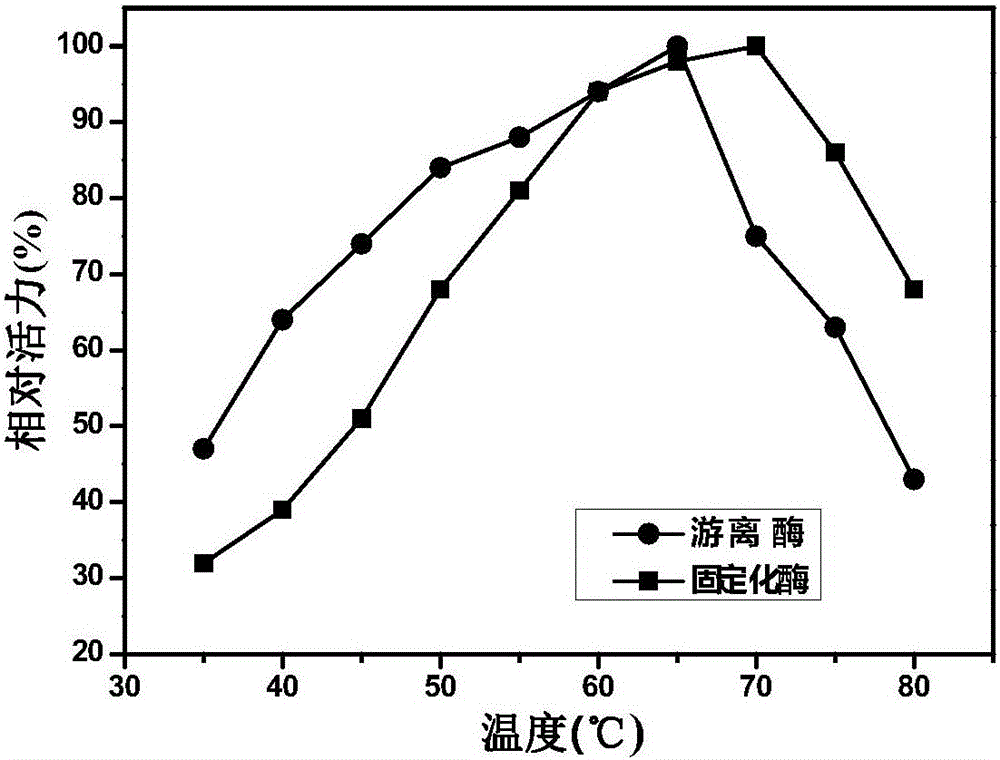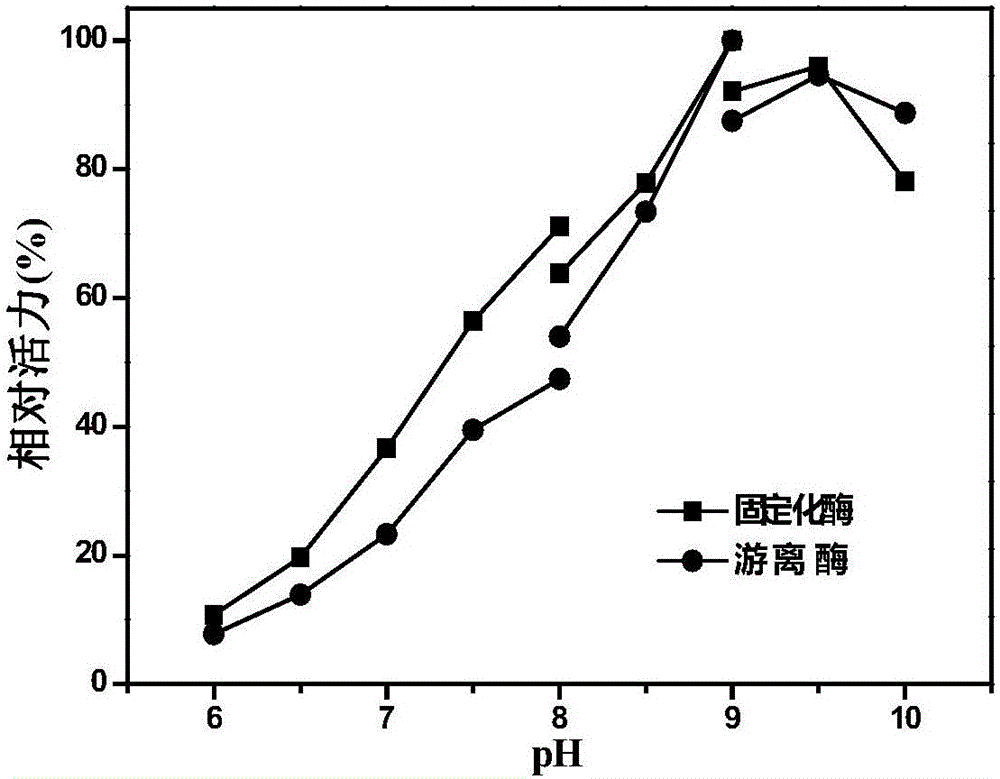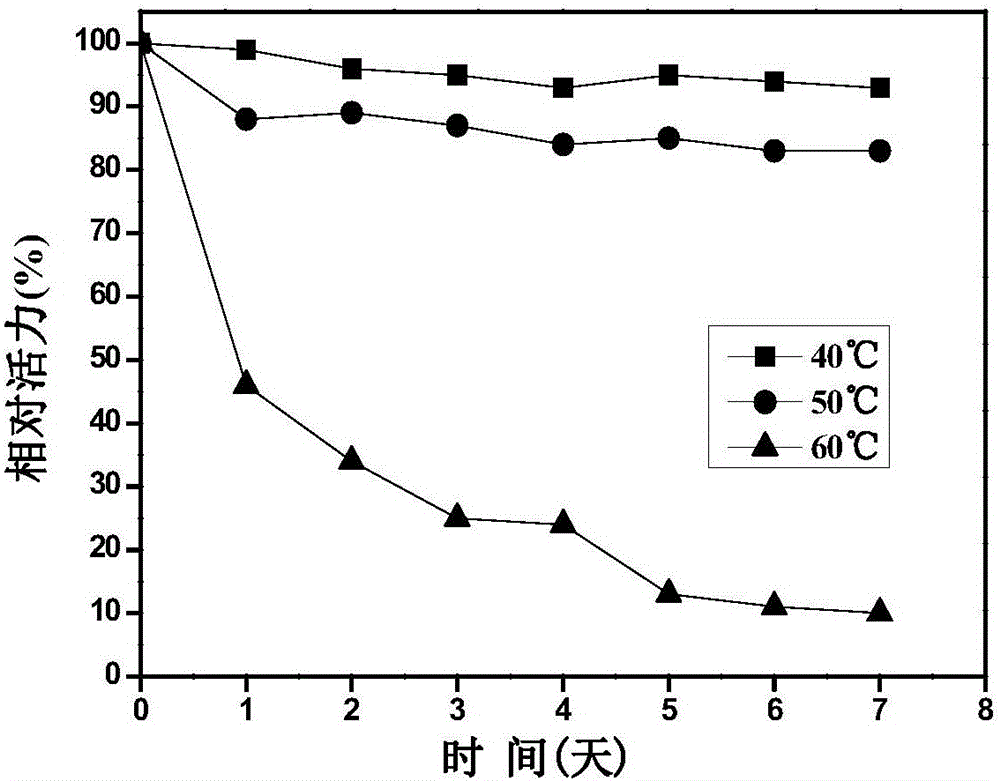Immobilized halohydrin dehalogenase and application thereof
A technology of halohydrin dehalogenase and enzyme immobilization, which is applied to the direction of immobilized on/in organic carriers, halocarbon lyase, enzyme, etc., which can solve the problems of inability to meet industrial production requirements, poor stability, etc., and achieve excellent operation Effects of stability and high adsorption efficiency
- Summary
- Abstract
- Description
- Claims
- Application Information
AI Technical Summary
Problems solved by technology
Method used
Image
Examples
Embodiment 1
[0043] Example 1 Construction and Fermentation of Recombinant Halohydrin Dehalogenase Genetic Engineering Bacteria
[0044] 1) Construction of recombinant halohydrin dehalogenase gene engineering bacteria: the halohydrin dehalogenase gene HHDH (nucleotide sequence shown in SEQ ID NO.1) was ligated with PGEM-T vector and introduced into E.coli JM109 , HHDH / PGEM-T and plasmid pET28b(+)-Nit were double digested, ligated overnight with ligase, and the ligation product pET28b(+)-HHDH was introduced into the host E.coli BL21(DE3), and recombinant E. coli was obtained by screening E. coliBL21(DE3) / pET28b(+)-HHDH.
[0045] 2) Fermentation of recombinant halohydrin dehalogenase genetically engineered bacteria
[0046] (1) Slant culture: Inoculate the recombinant E. coli BL21(DE3) / pET28b(+)-HHDH into the slant medium containing a final concentration of 50 μg / ml kanamycin, and culture at 37°C for 12 hours to obtain slant cells The final concentration of the slant medium consists of: pe...
Embodiment 2
[0049] Example 2 Preparation of Crude Enzyme Liquid of Recombinant Halohydrin Dehalogenase
[0050]Wash the recombinant halohydrin dehalogenase cells obtained in Example 1 with clear water, dissolve them with a certain amount of pH=7.0, 0.1M sodium phosphate buffer, prepare a bacterial suspension with a concentration of 1g / 10mL, and store them on ice Ultrasonic treatment (240W, ultrasonic 1s, interval 1s) in a water bath for 20 minutes to break the cells, the broken solution was centrifuged at 9000rpm at 4°C for 10 minutes, the supernatant was the crude enzyme solution, and the enzyme content was calculated as 0.1 by the weight of the wet cells before breaking. g / ml. Then take 1 ml of the supernatant, and use the BCA protein content detection kit (Nanjing Kaiji Biotechnology Development Co., Ltd.) to determine that the protein content of the crude enzyme solution is about 10 mg / mL.
Embodiment 3
[0051] Example 3 Immobilization of recombinant halohydrin dehalogenase
[0052] 3.1 Selection of carrier
[0053] Carry out preliminary experiments to screen out potential carriers, and then carry out detailed immobilization conditions for the selected carriers.
[0054] Epoxy resins produced by different manufacturers have different parameters such as water content, pore size distribution on the carrier surface, and epoxy density, which will cause certain differences in the final results when immobilizing enzymes. Considering the price difference of epoxy resins at home and abroad, four kinds of epoxy resins, LX-1000EP(C) from Xi’an Lanxiao Technology Co., Ltd. and ES-1, ES-105 and ES-103B from Nankai Technology Co. Alternative immobilization carrier.
[0055] Take 10mL of the crude enzyme solution obtained in Example 2 and add it to 200mL, pH=7.0, 0.1M sodium phosphate buffer solution, mix well to form the enzyme solution to be immobilized; mix the enzyme solution to be im...
PUM
 Login to View More
Login to View More Abstract
Description
Claims
Application Information
 Login to View More
Login to View More - R&D
- Intellectual Property
- Life Sciences
- Materials
- Tech Scout
- Unparalleled Data Quality
- Higher Quality Content
- 60% Fewer Hallucinations
Browse by: Latest US Patents, China's latest patents, Technical Efficacy Thesaurus, Application Domain, Technology Topic, Popular Technical Reports.
© 2025 PatSnap. All rights reserved.Legal|Privacy policy|Modern Slavery Act Transparency Statement|Sitemap|About US| Contact US: help@patsnap.com



